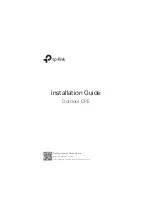
9
Installation Safety and Site Preparation
General Site Requirements
Never assume that power is disconnected from a circuit. Always check.
Never open the enclosure of the router’s internal power supply.
If an electrical accident occurs, proceed as follows:
—
Use caution; do not become a victim yourself.
—
Turn off power to the device.
—
If possible, send another person to get medical aid. Otherwise, assess the victim’s condition and then call for
help.
—
Determine if the person needs rescue breathing or external cardiac compressions; then take appropriate action.
Warning:
Do not work on the system or connect or disconnect cables during periods of lightning activity. Statement
1001
Preventing Electrostatic Discharge Damage
Electrostatic discharge (ESD) can damage equipment and impair electrical circuitry. It can occur if electronic printed
circuit cards are improperly handled and can cause complete or intermittent failures. Always follow ESD prevention
procedures when removing and replacing modules:
Ensure that the router chassis is electrically connected to earth ground.
Wear an ESD-preventive wrist strap, ensuring that it makes good skin contact. Connect the clip to an unpainted
surface of the chassis frame to channel unwanted ESD voltages safely to ground. To guard against ESD damage and
shocks, the wrist strap and cord must operate effectively.
If no wrist strap is available, touch a metal part of the chassis to discharge any electromagnetic build up.
Caution:
For the safety of your equipment, periodically check the resistance value of the antistatic strap. It should
be between 1 and 10 megohms (Mohm).
General Site Requirements
This section describes the requirements your site must meet for safe installation and operation of your router. Ensure that
the site is properly prepared before beginning installation. If you are experiencing shutdowns or unusually high errors
with your existing equipment, this section can also help you isolate the cause of failures and prevent future problems.
Rack Mounting
The router is designed for mounting on a DIN rail, or a wall. Cisco recommends that the router not be rack mounted.
However, if you install the router in a rack, follow these guidelines:
Allow clearance around the rack for maintenance.
Allow at least one rack unit of vertical space between routers.
Enclosed racks must have adequate ventilation. Ensure that the rack is not congested, because each router
generates heat. An enclosed rack should have louvered sides and a fan to provide cooling air. Heat generated by
equipment near the bottom of the rack can be drawn upward into the intake ports of the equipment above.
Summary of Contents for Firepower 1120
Page 4: ...4 ...
Page 34: ...34 Router Hardware Description Hardware Features ...
Page 44: ...44 ...
Page 66: ...66 ...
Page 92: ...92 ...










































